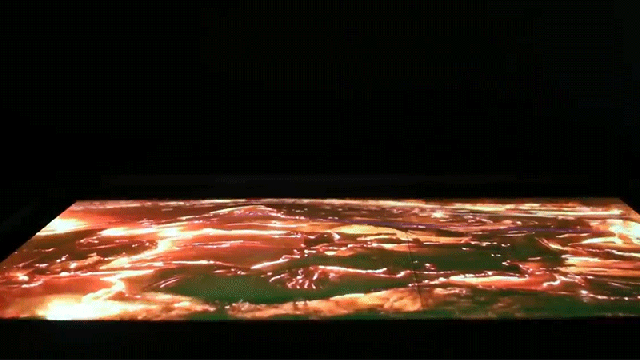It’s impressive that in just 15 years modern smartphones have already advanced to the point where they can bend and fold to more easily squeeze into a pocket. But the evolution of flexible displays is far from over, and Samsung has recently demonstrated an OLED that can stretch like it’s made from rubber.
It’s not uncommon for companies like LG and Samsung to roll out massive TV displays to impress the crowds at tradeshows, but at the recent Global Tech Korea 2021, Samsung had a much smaller display — just 13-inches in size — demonstrating one of the newest tricks of flexible OLED screens. Instead of rolling, bending, twisting, or folding, which are tricks we’ve seen OLEDs do time and time again, Samsung revealed a new display that can bulge and stretch while returning to its original perfectly flat state without signs of damage or wear.
The specific demo had the 13-inch display playing footage of a lava flow and appearing to match the natural movements of the fiery material as it bulged and bubbled while making its way across the screen. It’s a neat trick, but not necessarily something users have been demanding from their flatscreen devices. We tried 3D, no one wanted it, and the last thing anyone wants is the email icon on their smartphones trying to grab their attention by appearing to burst out of the device through the screen. But the technology does have some other interesting applications.
For starters, improving the flexibility of an OLED screen, and its ability to ‘snap back’ and recover from being folded or bent, will help minimise one of the big downsides of the current crop of folding smartphones: a visible crease that over time gets more pronounced. Fold a piece of paper and it’s permanently damaged, resulting in a visible crease that will never go away. Fold a thin sheet of rubber and it will look perfectly fine with no visible signs of damage after it’s unfolded.
A flexible screen that can subtly bulge also opens up new opportunities for how we interact with a touchscreen. Trying to use on-screen touch controls to play a video game is problematic because there’s no tactile feedback like there is with a controller in hand. You have to divide your focus between keeping an eye on the action in the game, and ensuring your fingers are properly positioned over on-screen buttons. But if those buttons were slightly raised so that your fingers could feel and distinguish them, gaming on a touchscreen device would suddenly be much different.
There’s also the potential of a stretchable OLED screen being used as a tool for the visually impaired, letting Braille letters instantly appear on screen, or giving texture and depth to images so they could be interpreted through touch. Of course, these applications depend on several factors, including to what degree an OLED can be stretched (could tiny bumps actually rise high enough to be felt?) as well as the development of under-display actuators to actually warp and stretch the screen with more fidelity and detail than what Samsung recently demonstrated.
